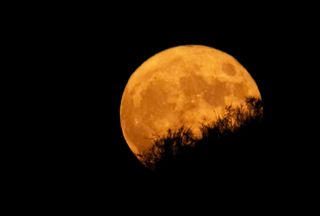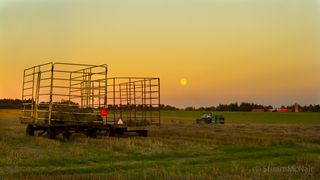How frequent is the full Harvest Moon?

With summer temperatures persisting the way they have, especially across the eastern half of the country, it seems hard to believe that tonight (Sept. 20), is the night of the full Harvest Moon, always the full moon closest to the time of the autumnal equinox.
Check the Almanac section on the weather page of your local newspaper this week to see when the moon will rise each evening (or look it up online). Notice that the following evening's rise will be about 21 to 26 minutes later than the evening before. That's generally half of the normal night-to-night change of 50 minutes.
The reason for this phenomenon is the way the ecliptic — the path the sun, moon and planets appear to take across the night sky — lies nearly along the eastern horizon around the time of sunset. Since the moon's daily motion follows the ecliptic, and its rise path at this time of year lies on a gentle slope nearly parallel to the horizon, most of its change these days works to keep the rising time nearly the same each evening.
Related: Harvest Moon 2021: When and how to see September's full moon
More: How to photograph the moon using a camera: techniques, kit, and settings
Orion GoScope II 70 Telescope Moon Kit: $89.99 at Amazon
If you know a youngster who can't get enough of the moon, then they'll be delighted with views through the Orion GoScope II. Revealing craters and seas up close, this little telescope comes with a carry case and moon map.
In any case, the Harvest Moon was for a long time important to the farmer, serving as a welcome lantern in the night sky. Lingering in the twilight evening sky as it will for several nights in a row, gave him the equivalent of an extra day or two at harvest time. That was back in the days before there were mechanical harvesters when the anxious farmer was pressed by the season and welcomed those several nights of bright moonlight to stretch those shortening days in fields that had to be harvested before the farm could be closed for the approaching winter season. And in spite of most modern farmers taking full advantage of our 21st-century technology, there are probably still a few places where some farmers will be out in the moonlight, gathering corn.
Range of Harvest Moon dates
This year's Harvest Moon actually occurs during the summer season. The moon will officially turn full at 7:55 p.m. EDT (2355 GMT) on Monday, or 1.8 days before the official start of the autumn season with the equinox on Wednesday (Sept. 22). In properly branding a full moon as a Harvest Moon, we need to go up to two weeks before or up to two weeks after the date of the equinox. Since the September equinox vacillates between Sept. 22 and Sept. 23, means that we can have the Harvest Moon come as early as Sept. 8 or as late as Oct. 7.
Thus, there is a 29-day interval when we can designate a particular late-summer or early fall full moon as a Harvest Moon. Which date or dates are most likely to have a Harvest Moon? And which dates are least likely to have one? To answer these and other calendar-related questions, we referred to the book "Astronomical Tables for the Sun, Moon and Planets" by celestial calculator extraordinaire, Jean Meeus. His book lists the dates for all equinoxes and solstices for the years 1 to 3000 AD and phases of the moon from 1970 to 2050.
Get the Space.com Newsletter
Breaking space news, the latest updates on rocket launches, skywatching events and more!
So, we did a check for all the full moons occurring closest to the September equinox during an 80-year time frame and this is what we found:
During the years that we examined, the majority of dates in the Sept. 8 through October 7th timeframe have seen a Harvest Moon at least three times, but there were four dates in which a Harvest Moon occurred as many as four times (the most frequent number possible during our 80-year sampling). Those dates are Sept. 8, Sept. 10, Sept. 15 and Oct. 5. Conversely, there's only one date on which a Harvest Moon did not occur even once during our 80-year sampling: Sept. 9.
Interestingly, at opposite ends of the timeline, Sept. 8 — the earliest for a possible Harvest Moon — has occurred a maximum of four times, in 1972, 1995, 2014 and 2033. Notice, incidentally, how each case is separated by 19 years, the so-called Metonic cycle named for Greek mathematician, astronomer, geometer, and engineer, Meton of Athens, who lived in Athens in the 5th century BC.
Yet, Oct. 7 — the latest possible date for a Harvest Moon — has only occurred just once, in 1987.
October Harvest Moons occur on average once every five years, although there are variations. There were October moons in 2017 and 2020 (three years apart) and after 2028, the next one won't come until 2036 (eight years later). Our next October Harvest Moon will be Oct. 6, 2025.
Harvest Moons on the equinox
Of course, a "true" Harvest Moon would be one that coincides with the date of the autumnal equinox. We found only three such cases: in 1991, 2029 and 2048. In 2029, the moon will turn full only 69 minutes before the official start of autumn. Of these three cases, only 1991 saw autumn arrive first, followed about 10 hours later by the occurrence of the full moon.

Effects on weather?
While calendars and almanacs proclaim that Harvest Moon branding goes to the full moon nearest to the autumnal equinox, that is the logic of the astronomer; those who have lived out their lives in the country would more likely call it an absurdity; to these folks, the "rural" Harvest Moon cannot, and should not occur until after equinox. By this standard, the 2021 "summer" Harvest Moon is too early, although coming less than two days before the official start of fall, they just might go along with the Harvest branding.
What the Harvest Moon means, early or late, is rarely, if ever, discussed by meteorologists. In Eric Sloane's Almanac and Weather Forecaster, is a poem that reads:
The moon and the weather
May change together;
But change of the moon
Does not change the weather.
If we'd no moon at all,
And that may seem strange,
We'd still enjoy weather
That's subject to change
Still, if the moon governs the tides in the Earth's vast oceans, might it also be a consequence in the behavior of our atmosphere? In his Treatise on Meteorology, written in 1868, Elias Loomis told of a "feeble lunar tide in the atmosphere, similar to that of the ocean." Today, scientists believe that if such a tide exists it is so slight that no effect is exerted on our weather.
Regardless, we have had a tempestuous summer complete with extreme heat and raging wildfires in the West, and frequent rains with occasional tropical cyclones passing through in the East. The traditional calm of the Harvest Moon would be especially welcome this year; it might even usher in a long, benign autumn. But don't bet on that. All we can be sure of is that very soon we'll be enjoying a series of early evenings filled with moonlight — if your skies are clear.
Joe Rao serves as an instructor and guest lecturer at New York's Hayden Planetarium. He writes about astronomy for Natural History magazine, the Farmers' Almanac and other publications. Follow us on Twitter @Spacedotcom and on Facebook.
Join our Space Forums to keep talking space on the latest missions, night sky and more! And if you have a news tip, correction or comment, let us know at: community@space.com.

Joe Rao is Space.com's skywatching columnist, as well as a veteran meteorologist and eclipse chaser who also serves as an instructor and guest lecturer at New York's Hayden Planetarium. He writes about astronomy for Natural History magazine, the Farmers' Almanac and other publications. Joe is an 8-time Emmy-nominated meteorologist who served the Putnam Valley region of New York for over 21 years. You can find him on Twitter and YouTube tracking lunar and solar eclipses, meteor showers and more. To find out Joe's latest project, visit him on Twitter.

